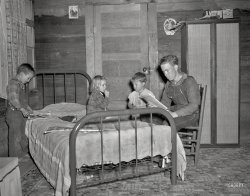
MAY CONTAIN NUTS

Search Shorpy
SHORPY ART

Framed or unframed, desk size to sofa size, printed by us in Arizona and Alabama since 2007. Explore now.
Join and Share
Ad-Free Shorpy
Shorpy is funded by you. Patreon contributors get an ad-free experience.
Learn more.

Recent comments
- +112
- Rear View
- Way in the back --
- Button It Up
- And with an eye on the time ...
- Working in an enclosed ashtray
- Rear View Mirror?
- Tobacco cam
- Basic fact I learned only later in life
- Put a Lid on it!
- Pinstripes in the Tower
- Sound enhancement
- 3438 in '38
- Second Career
- Their days are numbered
- Only the Sensor
- Train control mechanism
- Rarest of the Rare?? & Classy 3400 Class
- Control Mechanism
- Those standpipes
- Wrenches
- International D-40 I believe
- Job prospects
- You had me at Train
- Land of the free
- Broad-Exchange Bldg
- Parking innovation
- The old block
- "Peck turned a sweet propeller"
- National Bank Building
Member Photos
The Shorpy
Printporium
Printporium
Search Shorpy
Search results -- 30 results per page
- The Crucible: 1920
- ... Uranium? Well yes, I did notice my hands glowing last night. Do I plan on having children someday? Yes, why do you ask? Who is my ... Posted by Dave - 08/27/2012 - 2:42pm -
![The Crucible: 1920 Circa 1920. "Bureau of Mines, Department of Interior, Washington." Harris & Ewing Collection glass negative, Library of Congress. View full size.
DatingGood thing there's a date for this, albeit approximate. You could Fark that guy out and stick him in a 1950s, even up to mid-1960s shot and nobody'd notice.
[I just found an exterior shot from the batch of photos showing cars with 1920 license plates, so I've changed "circa 1910-1915" to 1920. - Dave]
Why is it glowing?"What did you say this stuff is called Dr. Oppenhiemer? Uranium? Well yes, I did notice my hands glowing last night. Do I plan on having children someday? Yes, why do you ask? Who is my next of kin?"
Lab TestThe same Corning ceramic crucibles. The same basic oven, though I don't remember the brand. The same tongs. This could be a quality control laboratory at Tennessee Eastman in the late 1950's when I started work there. We used this equipment to determine percent ash on photographic chemicals and other chemicals from production. We had learned to wear gloves and protective glasses by then.
MarshmallowsWhen I first glanced at the photo, I thought the guy was toasting marshmallows.
The Hot MetallurgistI could positively eat this young man with a spoon.
[Or maybe a shovel. - Dave]
(The Gallery, D.C., Harris + Ewing, Mining)](https://www.shorpy.com/files/images/14230a.thumbnail.jpg)
- Nicollet Avenue: 1904
- ... Department store, which burned down on Thanksgiving night 1982. Arson suspected.
Donaldson's Dome I believe they had a ... Posted by Dave - 11/10/2017 - 6:41am -
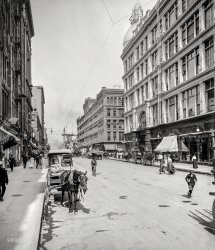
- Naked Truck: 1919
- ... not jammed on tight, it might take flight, but driving at night must have been difficult by kerosene light.
But each wheel spoke has ... Posted by Dave - 10/04/2017 - 1:49pm -
![Naked Truck: 1919 San Francisco circa 1919. "Sandow motor truck." Latest entry on the Shorpy List of Lapsed Lorries. 5x7 glass negative by Christopher Helin. View full size.
Seatbelts ON! Just think, this truck has solid rubber tires, providing no cushioning that pneumatic tires would provide, has no shock absorbers to speak of, and no seat belt. The beefy leaf springs don't look as if they would flex much on each pothole. The only cushioned thing is the horsehair he's sitting on. The driver must have had to hang onto the steering wheel to stay seated. Lacking a windshield, if that bowler is not jammed on tight, it might take flight, but driving at night must have been difficult by kerosene light.
But each wheel spoke has pinstripes.
GreatRadiator; very distinctive and memorable. Regarding windshields and such, sure most of those items would be part of the final vehicle design as specified by purchaser.
BTW, wonder if Sandow was the same strongman featured by Flo Ziegfeld and depicted in the movie The Great Ziegfeld. Probably so, interesting factoid.
Pretty awesomeThere is virtually no information extant these days on this Sandow truck, which is a pity. The rear suspension is very advanced for the time, and better than what you get on a five-ton truck today!
The springs are not required to do anything but be springs. Location of the axle fore and aft is by huge trailing arms, and a Panhard rod locates it laterally. The usual arrangement is for the leaf springs to do both as on brand new Ford and Chevy pickups and medium duty Navistars, and it isn't elegant mechanically.
The rear axle itself is a worm drive from an outside supplier, quite common at the time. Nice photograph by Helin, the Hearst motoring and travel writer from 1915 to 1929, who seems to have done quite well for himself.
http://yosemiteblog.com/2011/03/28/a-look-back-at-yesteryears/
PinstripesNo greasy t-shirt for this truckie! (Yes, I realize it's a publicity shot, and he's probably the regional sales manager, trying to look like he's doing real work)
A Strong NameProbably named after Eugen Sandow (1867-1925), the pioneering German bodybuilder and legendary strongman.
[That would be an excellent guess. - Dave]
(The Gallery, Cars, Trucks, Buses, Chris Helin, San Francisco)](https://www.shorpy.com/files/images/SHORPY-1218B.thumbnail.jpg)
- Crowded House: 1940
- ... there would always be a bed or two to spare. Maybe three night shift workers and three days?
Did Mrs. Jones supply ear plugs? ... Posted by Dave - 01/06/2020 - 3:11pm -
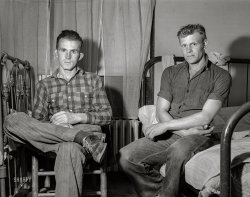
- Name That Airfield!
- ... on the roof in your photo. From what I read online last night, the building was covered in ugly concrete panels in the early 1960's so ... Posted by Jim Page - 09/28/2012 - 8:05pm -

- Typewriter Geek: 1922
- ... 17 years old, working in the pension office and attending night school. He lived at 509 F street NE and attended both Carberry and ... Posted by Dave - 08/10/2012 - 8:16pm -
![Typewriter Geek: 1922 Feb. 7, 1922. "Hobart Reese." Whose talent seems to have been an ability to type Abraham Lincoln the hard way. National Photo glass negative. View full size.
Old SchoolI always wondered how they did that ASCII art
Born Too SoonThis is so cool. He would have loved having a PC at work.
Quite well executed regarding the yearHobart must have spent some considerable time creating that gem. On the other hand, the splendid filing cabinet might contain many more examples of Hobart's creative art.
It would be nice to think that he kept his creations safe, and that this example, at least, survives and is currently sandwiched between the pages of a friend's, or family member's, book.
I believe it would qualify as art, unlike a creation today, using a computer program to render a picture into text symbols.
Coat PocketI've never seen a side coat pocket shaped that way. Way custom tailored. Not sure at all the picture was done on a typewriter. He may be just typing a label.
[Typewriter art dates back to at least the 1890s. - tterrace]
The typewriterIt's a Monarch visible from around 1914 or 1915. Nice and heavy machines!
Cousin JollyHobart M. Reese (aka "Cousin Jolly") was a contributor of both letters and artwork to Aunt Anna's children's column and drawing contests in the Washington Post. In 1914 he is listed as 17 years old, working in the pension office and attending night school. He lived at 509 F street NE and attended both Carberry and Peabody School on Capitol Hill.
(Technology, The Gallery, D.C., Natl Photo)](https://www.shorpy.com/files/images/SHORPY_30183u.thumbnail.jpg)
- All You Can Eat: 1894
- ... in the South
… The Royal Poinciana at night is the centre of the show. Evening dress is de rigueur for dinner. ... Posted by Dave - 05/02/2015 - 6:02pm -
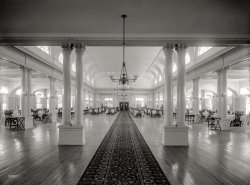
- Plugged In: 1941
- ... many lifetimes.
Too Many Cables For Me In 1968, the night manager at the Cove Inn in Naples, Florida, had the insane idea of having ... Posted by Dave - 06/16/2020 - 7:47pm -
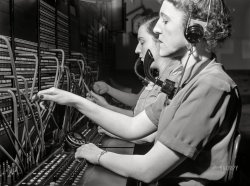
- Cornerman: 1943
- ... protection from unexpected rain (which frequently falls at night when cooler airs are more commonplace) allowing our airman to sleep as ... Posted by Dave - 12/04/2016 - 7:02pm -
![Cornerman: 1943 July 1943. Greenville, South Carolina. "Air Service Command. Enlisted man of the 25th Service Group relaxing in his hutment." Medium-format negative by Jack Delano for the Office of War Information. View full size.
"Squared Away"That young Airman has his corner of the hut neat & tidy, or as they say in the Military "squared away".
One thing that surprises me is that he appears to have 4 pairs of shoes. I wouldn't have thought they would have had that many pair in those days.
America's "Greatest Generation", not many of them left these days. God bless them all.
Two WordsPalmetto Bugs. My dad was stationed in the South at one point during WWII - the Palmetto Bugs were legendary.
About Those ShoesOur airman is wearing a pair of Brogans, an ankle high boot that was regular issue to Army personnel at the time. He also has a standard pair of boots under his bunk on the left, along with a standard pair of Army issue low quarter shoes (on the right). In the middle is a pair of shoes only Air Corps members were allowed to wear, wing tips! Like all low quarter shoes, they were only worn with the Class A uniform or any other off post, non-combat uniform combination.
Palmetto bugs?The south's euphemism for giant freaking cockroaches, and plenty of them!
The windowsI find the configuration of the two open windows very intriguing, never having seen this kind of window opening before. I must presume that the slot & pin arrangement allows the window to be the most fully open for maximum airflow yet still giving some protection from unexpected rain (which frequently falls at night when cooler airs are more commonplace) allowing our airman to sleep as peacefully as possible. Very nice, great photo. BTW - are those two little glue pots on the shelf?
[I think you're right. -tterrace]
(The Gallery, Jack Delano, WW2)](https://www.shorpy.com/files/images/SHORPY-8d32031a.thumbnail.jpg)
- Leif the Discoverer: 1899
- ... came.
"Where are my matelots? They were with me last night when I opened the celebratory wine barrel. I just checked and this sea ... Posted by Dave - 08/14/2018 - 3:59pm -
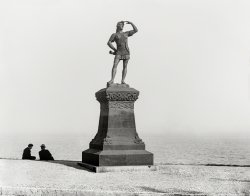
- Grand Hotel: 1908
- ... have cost s pretty penny. Would love to see this sign at night all lit up.
Oculus windows Found this pic on the LOC website, it ... Posted by Dave - 06/24/2014 - 4:07pm -
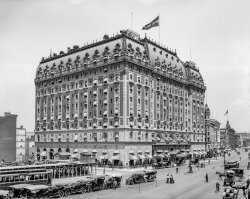
- Lights Up: 1929
- ... Where illumination seems to be the order of the day (or night). 5x7 glass negative. View full size.
Shocking? This is very ... Posted by Dave - 10/17/2017 - 9:18am -
![Lights Up: 1929 San Francisco circa 1929. "Dodge Brothers truck at City Hall." Where illumination seems to be the order of the day (or night). 5x7 glass negative. View full size.
Shocking?This is very odd - why would there be three enormous, ugly, high-tension electrical towers on the lawn of the City hall? Just to provide lighting of the building? Moreover they don't seem to be connected to anything, or even to each other!
[Temporary lighting for an event held in the City Hall plaza. -tterrace]
Why we have OSHAWe have a guy with no "personal protective equipment" climbing a (metal) ladder (injury lawyers love ladder manufacturers) towards 12kV while the ladder is mounted on a bouncy truck with no stabilizers. Yikes!
[The ladder is wood. - Dave]
OK, that's a little better, but still...Yikes.
Another fine productof the Dodge Light Truck Division.
No change in 88 yearsI like to see how things changed over the years but the bell string wire insulators of 1929 look just like the bell string insulators of today.
It's all in your perspectiveThe natty vested ladder climber is nowhere near the tower. To get to the tower from his truck, you'd have to cross the sidewalk, go over a low wall, across another walk, then past the woman on the park bench and finally into the shrubbery. It's a camera lens depth of field effect. It looks as though ladderman is actually going to inspect the ordinary streetlight.
[What he's really doing is promoting Dodge Brothers trucks. The Helin glass negatives are not documentary photography; they're publicity photos. - Dave]
That said, as someone who worked for a major electric utility for two decades, if city hall called us up and asked for the loan of three or more spare 115kV transmission line towers, double-circuited ones at that complete with pre-installed insulators, to just act as temporary spotlight stands, we'd have laughed our heads off. Then quoted a big price if they were insistent.
Those things would have to be assembled and taken down fairly painstakingly. Typically 70 or 80 feet tall, you don't just load 'em on a flatbed and truck 'em on over. They'd be bent up and dinged lying flat. Although, judging by the lack of safety standards they might have done just that given a long enough truck. Crazy. Amazing somebody didn't figure out a cheaper way to build temporary lighting platforms more appropriate to the task.
(The Gallery, Cars, Trucks, Buses, Chris Helin, San Francisco)](https://www.shorpy.com/files/images/SHORPY-1228B.thumbnail.jpg)
- Klein's in Biloxi
- ... 20 years. At the height of the postwar boom, Saturday night couples out on the town would line up on the sidewalk waiting for a table ... vacationing families and personalities. One summer night, veteran actor (and original voice of Frosty the Snowman) Billy de Wolfe ... Posted by FredKlein - 06/25/2008 - 10:17pm -
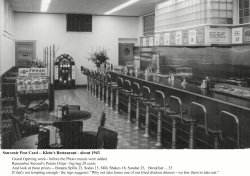
- Mr. Peanut: 1943
- ... and newspaper for when thing got slow to the lantern for night visibility and a bag of peanuts waiting to be roasted. I also see a broom ... Posted by Dave - 03/21/2017 - 7:08am -
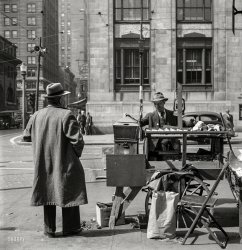
- Washington Noir: 1926
- "Pennsylvania Avenue at night." A wintry Washington, D.C., scene circa 1926. View full size. ... Posted by Dave - 07/17/2012 - 10:14pm -
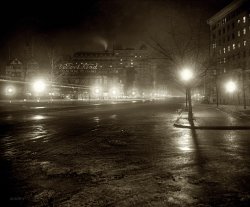
- Kentucky Tavern: 1940
- ... stripes. I cannot picture going down this road on a dark night, especially with a such a distinct lack of streetlights.
(The ... Posted by Dave - 11/07/2019 - 7:17pm -
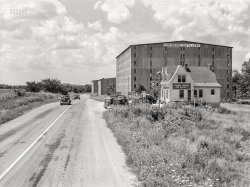
- Tastee Drinks: 1942
- ... black. My mother told me the reason, so not to be seen at night during the war. This yard worked 24/7 and closed in 1986.
+64 ... Posted by Dave - 07/18/2019 - 9:44am -
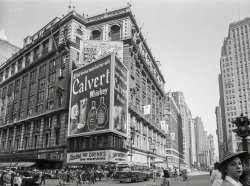
- Radio Highlights: 1957
- ... get up and re-arrange the furniture in the middle of the night if she couldn't sleep. Not popular with my bare-footed dad the next day ... Posted by Dave - 06/02/2017 - 12:50pm -
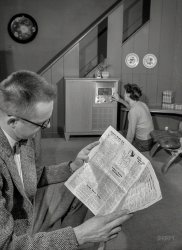
- Carbery Mansion: 1901
- ... shadows lengthen and the massive doors are locked for the night the spirit of the haunted house still lingers in the familiar ... Posted by Dave - 09/12/2011 - 5:02pm -
![Carbery Mansion: 1901 Washington, D.C., circa 1901. "Carberry [Carbery] Mansion." Built for Thomas Carbery in 1818 at 17th and C Streets N.W. National Photo Co. View full size.
Fixer-UpperThis is what used to be called a handyman's special, needs a little work. I'm not a snob, but calling this a mansion is a bit of a stretch.
Double-dare SpookyNothing in a neighborhood could fire a young boy's imagination quite like a huge run down and empty old house. I wish that I, along with my boyhood friends, could jump into this picture today.
On the EdgeThe mansion was razed in 1903; Carbery was Mayor of Washington from 1822 to 1824 and I'm sure the mansion was in better shape back then!
"Miracle House"I suppose I don't have the eye for spookiness which other commenters readily pick up on: before finding the following article I viewed this house as a typical run-down dwelling. Also, it seems to me (a non-Catholic) that Prince Hohenlohe received an inordinate degree of credit for Ms. Mattingly's "cure."
Miracle House
by Marie Lomas
Washington's Miracle House has again come to light. A water color painting discovered a few days ago by the curator at a local museum brings up a story stranger by far than many of the bizarre tales of fiction. Although separated from its identification marks, the picture has been established as a rear view of the Miracle House, or Ghost House, as it was sometimes called, down in the neighborhood of "Foggy Bottom."
...
Even as the residence of Capt. Thomas Carbery in 1824, it was familiarly known as the the Miracle House, for it was here that the famous Mattingly miracle occurred.
The legend, which will accompany the picture now carefully guarded behind locked doors of a display case in the D.A.R. museum, states: "This house, in 1824, was the residence of the Mayor, Capt. Thomas Carbery, and living with him was his widowed sister, Mrs. Ann Mattingly, a great sufferer and confirmed invalid. Marvelous cures were being made by Prince Alexander Hohenlohe, a Catholic Priest of Bomberg, Germany, throughout Europe. His Highness stated to the Diocese of Baltimore that he would offer up a prayer the tenth of every month at 9 a.m. for those living out of Europe.
"Mrs. Mattingly performed a novena, or nine days' devotion, commencing March 1, 1824, assisted by the pastor of St. Patrick's Church, and on March 10 she was relieved of all pain and, although bedridden, rose from her bed and opened the door to callers."
This miracle was sworn to before John Marshall, Chief Justice of the United States, and immediately aroused great excitement throughout Washington.
No doubt the setting was partially responsible for many of the later stories in connection with Miracle House, which soon became and enigma to the residents of lower Washington. Situated near the canal and lock houses, which still stand on Constitution avenue and Seventeenth street, it was at the edge of what was considered a dense and dangerous jungle. The nearby shores were covered with an almost impenetrable growth of somber trees shrouded in tangled vines. Hoarse croaking of frogs and the screams of swamp fowl pierced the abysmal darkness of the nights.
Even Scott, the major-domo of the great marble edifice built by the D.A.R. on the site of the "Ghost House," vouches for the mystery of its unknown inhabitants. He recalls today his frog-catching expeditions into the swamps near the house, "We could see people in there and sometimes a light," he said, "but nobody ever came out."
In its later days it was deserted, but the latest happenings at the "haunted house," as it was called by the little Negro boys of Foggy Bottom, continued to be the news of the day.
The house was demolished in 1903 to make way for Memorial Continental Hall. Perhaps when shadows lengthen and the massive doors are locked for the night the spirit of the haunted house still lingers in the familiar surroundings of aristocratic Hepplewhites, Chippendales, Duncan Phyfes and shining Steigle glass. After all, it was in the basement of this museum, on the site of the Miracle House that the picture came to light.
Washington Post, Nov 3, 1937
LOTS of wires on that pole...So.. are the wires telephone/telegraph wires or "newfangled" electric wires? In 1901 electricity was relatively new, while telephone/telegraph had been around for 25+ years by that time.
What is interesting is that there was no such thing as a big trunk cable. Looks like everything was run individually. I can remember seeing other old photos here on Shorpy of city scenes that showed poles literally ready to fall over with the weight of so many wires on them.
Imagine what our cities, and towns for that matter, would look like today if poles were huge with tons of individual wires running on them!
(The Gallery, D.C., Natl Photo)](https://www.shorpy.com/files/images/00178u.thumbnail.jpg)
- Tex Williams: 1953
- ... keeps it there, he says, so it's the last thing he sees at night and the first thing he sees in the morning.
Are some Martins more ... Posted by Dave - 12/07/2015 - 3:28pm -
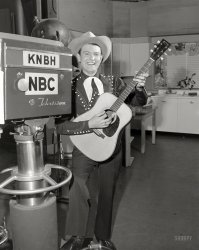
- Daddy Folds a Dydee: 1943
- ... drawer crib is moved to the side of their bed for the night." The Massmans were a young Navy family whose lives in Washington, ... Posted by Dave - 09/09/2011 - 11:34am -
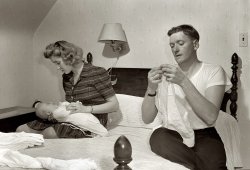
- The Underground: 1915
- ... the crew. All the older guys would say "Saftey First" all night long to us new guys over and over. We always had a chuckle and thought ... Posted by Dave - 03/03/2008 - 2:00pm -
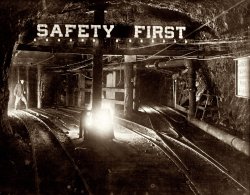
- Harlem River Speedway: 1905
- ... 7 days, from 8 o'clock in the morning until 6 o'clock at night, during the early part of last month showed that during this time only ... Posted by Dave - 08/20/2012 - 1:38am -
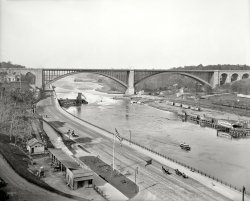
- Kitchen Klatch: 1959
- ... 3:15 and it's dark outside so this is the wee hours of the night, either it's New Years or these are hard core party people.
The ... Posted by Deborah - 09/26/2013 - 7:04pm -
![Kitchen Klatch: 1959 January 1959. In this prequel gathering of the California Picnic group here, we have Ruby Lee and her hubby (back right), their daughter Peggy (def. too young to drink) cozying up to declared hottie Clay (who is not Thomas Cave a.k.a Mr. 535-07-5248) as his wife gamely looks on. Part of the Humphries Family Kodachrome collection. View full size.
Perhaps January 1st?It's 3:15 and it's dark outside so this is the wee hours of the night, either it's New Years or these are hard core party people.
The kitchen is classic! the colors, the appliances, the clock, very nostalgic.
[The clock says 9:15. - Dave]
So it does, the hour hand was blotted out by the flash. "Never mind"
[Actually, this was taken by available light, not flash. -tterrace]
Familiar FurnitureI see a wonderful old kitchen table peeking out there. I remember we had a table like that with the aluminum (?) sides and the great chairs that matched. Great photo.
So what's the brand?Not one but two cans of beer visible, and I can't quite make out the brand name. It appears to be Buck[something]. Two brands around in 1959 that would have started with Buck were Buckhorn, produced by Olympia Breweries in Texas, and Buckeye, an independent brand from (duh!) Ohio. Neither one's logo was similar to that in the picture and it's doubtful that either would have been distributed in California.
Grandmother's Kitchen TableMy grandmother had that same table-and-chairs set, with the same pattern cushion covers, in her kitchen as well. Wedged into about the same amount of space!!
(ShorpyBlog, Member Gallery)](https://www.shorpy.com/files/images/Kodachrome_NewKitchen_0.thumbnail.jpg)
- Life in the Slow Lane: 1910
- ... was her brother who worked at that job for fifty cents a night in the late 40s and early 50s. She made that same rate of pay working as ... Posted by Dave - 05/23/2010 - 11:39am -
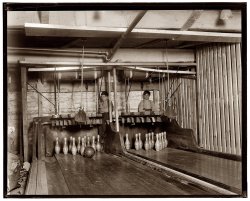
- Polka-Dot Tot: 1958
- ... 1958, somewhere in Pennsylvania, getting ready for the big night! Our third slide from this batch of 35mm Kodachromes. View full size. ... Posted by Dave - 10/27/2012 - 2:16pm -
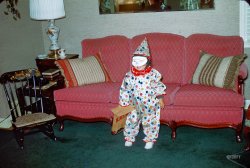
- Civil War Signal Tower: 1864
- ... transmit coded messages, used flags by day and torches by night.
hey i used to live in that area. thats probably where the strip ... Posted by Dave - 09/17/2009 - 8:54am -
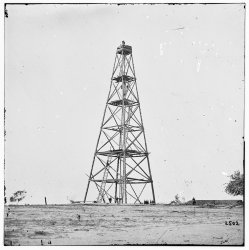
- Lower Wider Smarter: 1946
- ... Grand Boulevard, working his way through college on the night shift, with a locker full of books to study on his breaks. Still to this ... Posted by Dave - 06/09/2016 - 1:39pm -
![Lower Wider Smarter: 1946 September 12, 1946. Washington, D.C. "Showroom at Superior Motors. Client: Griffith-Consumers Co." Step into the FUTURE today with the Packard Clipper! 8x10 acetate negative by Theodor Horydczak. View full size.
Just Add WaterNote the faux-seashore complete with sand, palm trees and beach umbrella.
End of an eraAlthough Packard introduced the Clipper in 1941, 1946 was the first model year that saw total abandonment of the classy vertical louvered grille that had distinguished most Packards starting with 1933, and even earlier on some models. Once Clipper-type styling got perfected with the Custom line in 1950, that also got abandoned. And it was downhill from that point on. Already joined with Studebaker, the last authentic Packard was built in June 1956. The marque that was once among the top rated "3 Ps" (Packard, Peerless and Pierce-Arrow) amounted to little more than rebadged Studebakers for the next two years. Then, nothing.
Happy days are here again!I turned 7 on that very day. The war was over, soldiers were returning home, no more food rationing, families and lovers were reuniting, prosperity was booming and America had emerged victorious. I wish the spirit of that exhilarating, invigorating and revitalizing era could have been permanent. If I could keep time in a bottle, that would fill one of my treasured bottles. Life was good.
[Unless you were dead. -Dave]
Some future!A decent car, the Packard Clipper, though far from the marque's pre-war standards of luxury. The body is a pre-war holdover, and mechanically the small straight-8 engine, though smooth and reliable, was hardly a harbinger of things to come either.
Except for the new brands -- Kaiser, Frazer, the token production of Tucker -- it was 1947 before any radically new coachwork was being produced by a major manufacturer: Studebaker, followed a year later by Hudson and then Nash. Obviously the majors, having a heavy investment in their 1941-42 body dies and facing a seller's market after the war, held on the longest, badge-engineered pre-war cars until 1948 and '49.
Though there was much reason for euphoria after the war, rationing did not end immediately upon V-J day, though by late '46 I suspect it had. I recall being punished by my father, recently returned from the Pacific, for ruining a rationed item by attempting to blow away a cigarette ash he'd dropped on the tablecloth. (Yes, smoking and eating were complementary activities in the winter of 1945-46). Instead, I blew the whole tray's worth of Chesterfield ashes onto a stick of still-rationed butter.
Our relationship went downhill from there.
Just a bit early for Father's Day The war was over. Rationing was slowly fading away. My grandmother was pushed off of her wartime job working on airplane engines so that returning servicemen, and Packard, could get back to the business of building cars.
But my dad was there in the big plant on East Grand Boulevard, working his way through college on the night shift, with a locker full of books to study on his breaks. Still to this day, at the age of 90, every time he sees an old Packard or Hudson (another plant where my father worked in those years) he says "I think I built that one".
(The Gallery, Cars, Trucks, Buses, D.C., Theodor Horydczak)](https://www.shorpy.com/files/images/SHORPY-5a43758u.thumbnail.jpg)
- Dale and the Pale Pumpkin
- ... of the year to write to the Great Pumpkin. On Halloween night, the Great Pumpkin rises out of his pumpkin patch and flies through the ... Posted by Dave - 10/27/2013 - 4:06pm -

- Chicken House: 1948
- ... the mattress were so insanely noisy they woke you up at night when you moved.
Little details I love the little photo to the left ... Posted by Dave - 08/28/2015 - 10:25am -
